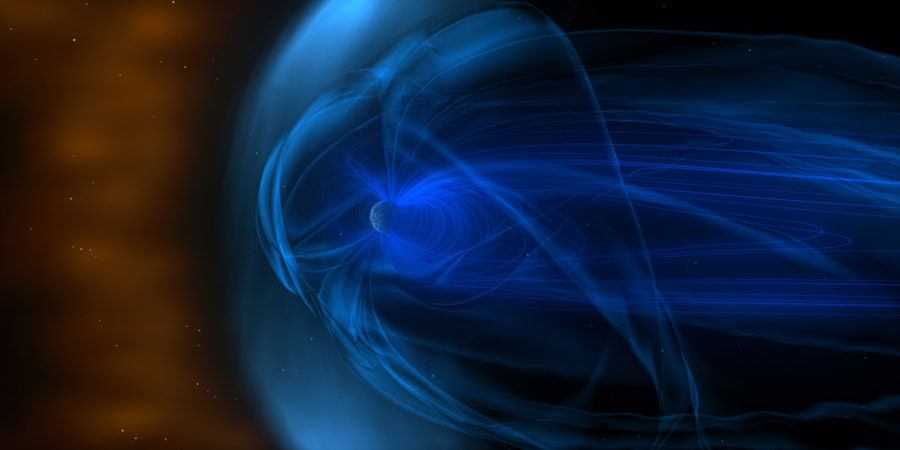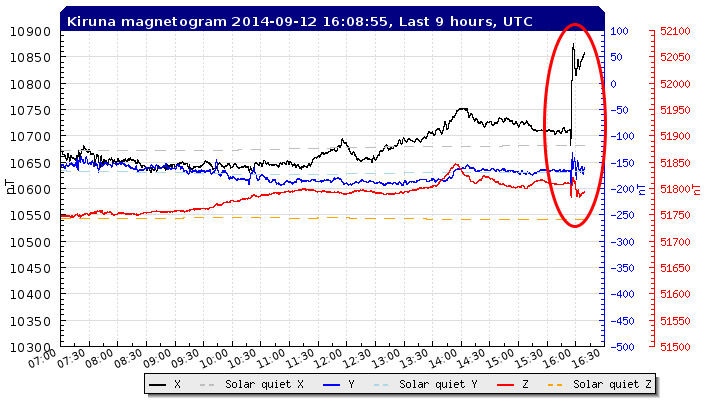X1.6 Coronal Mass Ejection impact!
Friday, 12 September 2014 15:33 UTC

It's here! The Coronal Mass Ejection launched by the X1.6 solar flare that occurred two days has arrived at the ACE satellite. It passed ACE at 15:31 UTC which means the CME arrived right on time! In this article we will keep you up to date on the events as they unfold.
Even though we are only seeing the shock right now we can directly conclude that we are looking at a very decent impact. The speed of the solar wind rose to 670km/s and the IMF Bt jumped to a value of 26nT which is high. The direction of the IMF is not really responding at the moment and is near -2nT which is strange. This might change in the hours ahead as we pass the shock but it is at the moment a bit strange.
EDIT 15:50 UTC: The direction of the IMF is now responding and jumped to 10nT north. This is not good for enhanced auroral conditions but it can still swing southward as we pass the initial shock.
Moderate #CME impact - Speed 670.2km/sec - IMF Bt (strength): 26.1nT. - Follow live on http://t.co/Gj5cI2OO1z pic.twitter.com/pg2Rdc2rR3
— SpaceWeatherLive (@_SpaceWeather_) 12 september 2014
In the hours ahead we will see what the IMF and solar wind stats are going to do as we reach the core of the CME, we should then also be able to make an estimate of what kind of geomagnetic activity to expect. At this moment the stats look good for a geomagnetic storm to develop but keep an eye on the live data that we provide to see for yourself how this event is unfolding.
Solar Radiation Storm - HELP
The high energy protons are now close to the moderate S2 solar radiation storm level following the CME arrival which means the solar wind data from ACE could become corrupt and show false readings, keep this in mind in the hours ahead. Effects of an S2 solar radiation storm here on Earth are: infrequent effects on HF radio in polar regions and satellite operations. EDIT 15:58 UTC: The S2 moderate solar radiation storm threshold has been crossed at 15:50 UTC.
Geomagneti
Magnetometers around the world recorded a Geomagneti

Direction of the IMF is heading south - Added 19:55 UTC
The direction of the IMF is turning south following long period of north Bz. Strong G3 geomagnetic storming remains possible in the coming hours but it is vital that the direction of the IMF remains south!
Direction of the IMF is north - Added 0:40 UTC
It is starting to look that we are inside the inner core of the X1 CME and the direction of the IMF looks to be holding firmly north. The solar wind speed remains high near 700km/s and G2 geomagnetic storming has been observed by the Wing Kp-index, and NOAA even reported a period of G3 geomagnetic storming. Aurora were seen from the northern tip of the Netherlands and northern parts of Germany but unfortunately not further south as you would expect with G3 conditions. The middle latitude auroral activity watch remains in effect but with the direction of the IMF being so stubborn north, G3 geomagnetic storming does not seem possible anymore. Sky watchers in the northern US should remain alert for auroral outbreaks but keep in mind that the northward pointing IMF will suppress the auroral activity.
NOAA SWPC alerts
WARNING: Geomagnetic Sudden Impulse expected Valid From: 2014 Sep 12 1545 UTC Valid To: 2014 Sep 12 1645 UTC IP Shock Passage Observed: 2014 Sep 12 1530 UTC
SUMMARY: Geomagnetic Sudden Impulse Observed: 2014 Sep 12 1555 UTC Deviation: 43 nT Station: Boulder
This post will be updated troughout the day so come back regularly. We would love to respond to all of the comments but unfortunately that is not possible. There are numerous ways to find out yourself if your location might have a chance for aurora like with the help of till exemple this page and this article.
Thank you for reading this article! Did you have any trouble with the technical terms used in this article? Our help section is the place to be where you can find in-depth articles, a FAQ and a list with common abbreviations. Still puzzled? Just post on our forum where we will help you the best we can!
Latest news
Latest forum messages
Support SpaceWeatherLive.com!
A lot of people come to SpaceWeatherLive to follow the Sun's activity or if there is aurora to be seen, but with more traffic comes higher server costs. Consider a donation if you enjoy SpaceWeatherLive so we can keep the website online!

Space weather facts
| Last X-flare | 2025/03/28 | X1.1 |
| Last M-flare | 2025/04/22 | M1.3 |
| Last geomagnetic storm | 2025/04/21 | Kp5+ (G1) |
| Spotless days | |
|---|---|
| Last spotless day | 2022/06/08 |
| Monthly mean Sunspot Number | |
|---|---|
| March 2025 | 134.2 -20.4 |
| April 2025 | 122.8 -11.4 |
| Last 30 days | 117.7 -15.6 |


